The role of design strategy in collaborative design processes

06/09/2023
In today's competitive business landscape, graphic design plays a crucial role in shaping brand identity and creating custom designs that resonate with target audiences. Many businesses rely on design services to maintain brand consistency and engage customers across various platforms. This article explores the importance of design strategy in collaborative design processes and how it can benefit businesses in achieving their creative goals.
What is Design Strategy?
Design strategy refers to the long-term planning and execution of design initiatives to achieve specific business objectives. It involves aligning design efforts with overall business goals and leveraging design as a strategic tool to drive innovation, differentiate from competitors, and enhance customer experience. Design strategy takes into account factors such as target audience, market trends, brand positioning, and user research to create effective visual solutions.
The Benefits of Design Strategy in Collaborative Design Processes
When design strategy is integrated into collaborative design processes, businesses can reap several benefits:
1. Design Partnership
A design partnership involves a close and ongoing collaboration between businesses and design professionals. By forming a design partnership, businesses gain access to tailored design solutions that align with their brand identity and business objectives. Designers become an extension of the internal team, working closely with stakeholders to understand their vision and translate it into visually compelling designs. This level of collaboration ensures that the design process is efficient, effective, and results in a visual identity that resonates with the target audience.
2. Ongoing Creative Support
Design strategy encourages businesses to seek ongoing creative support from design professionals. Instead of approaching design as a one-time project, businesses can benefit from continuous design services to maintain brand consistency and adapt to evolving market trends. Ongoing creative support allows businesses to stay ahead of the competition by consistently delivering high-quality design assets that reflect their brand values.
3. Design Retainers
Design retainers are a popular way for businesses to secure dedicated design resources on an ongoing basis. By entering into a retainer agreement, businesses can ensure that they have a dedicated designer who understands their brand and can provide design expertise whenever needed. Design retainers offer flexibility, allowing businesses to scale up or down their design needs based on their requirements. This arrangement also provides a cost-effective solution compared to hiring a full-time in-house designer.
4. Tailored Visual Identity
Design strategy enables businesses to create a tailored visual identity that sets them apart from competitors. Through collaborative design processes, businesses can work closely with designers to develop a visual identity that captures their brand essence and resonates with their target audience. This includes elements such as logo design, color palette, typography, and overall design style. A well-crafted visual identity enhances brand recognition and fosters a strong brand image in the minds of consumers.
How to Implement Design Strategy in Collaborative Design Processes
Implementing design strategy in collaborative design processes requires a systematic approach. Here are some steps to consider:
1. Define Business Objectives
Before diving into design, it is important to clearly define business objectives. This includes understanding the target audience, market positioning, and desired outcomes. By aligning design efforts with business goals, businesses can ensure that the design strategy effectively supports overall objectives.
2. Conduct Design Consultation
Design consultation involves engaging with design professionals to discuss project requirements, expectations, and timelines. This consultation phase allows businesses to communicate their vision and provide relevant information to designers. Designers can also provide insights and recommendations based on their expertise and understanding of design principles.
3. Collaborate on Design Concepts
Collaboration is key in the design process. Businesses and designers should work together to brainstorm and develop design concepts that align with the defined business objectives. This collaborative approach ensures that the design reflects the brand identity and resonates with the target audience.
4. Iterate and Refine
Design is an iterative process. It involves continuous feedback and refinement to ensure that the final design meets the desired standards. Businesses should provide constructive feedback to designers, and designers should incorporate the feedback to refine the design until it meets the desired outcome.
Conclusion
Design strategy plays a vital role in collaborative design processes. It helps businesses align design efforts with overall business goals, resulting in custom designs that effectively communicate brand identity and engage target audiences. By forming design partnerships, seeking ongoing creative support, and implementing design retainers, businesses can leverage design expertise to create tailored visual identities and maintain brand consistency. Through a systematic approach that includes defining business objectives, conducting design consultation, collaborating on design concepts, and iterating and refining, businesses can achieve their creative goals and stand out in the competitive market.
Contact us

Spanning 8 cities worldwide and with partners in 100 more, we’re your local yet global agency.
Fancy a coffee, virtual or physical? It’s on us – let’s connect!

